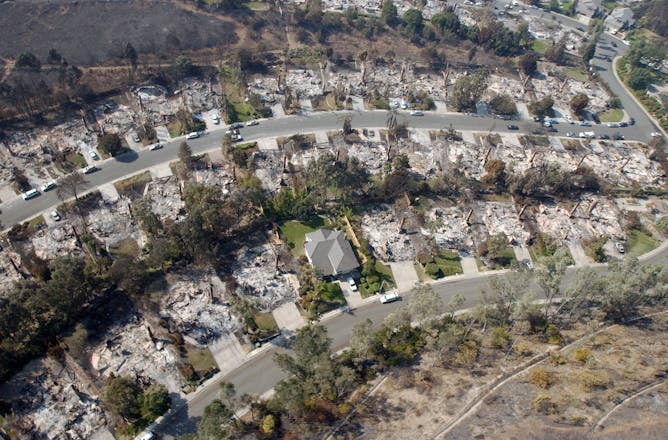|
|
|
|
Years ago when I was reporting an article on climate change and financial risk, I learned how the insurance industry, particularly the “reinsurers” that provide insurance to insurance companies themselves, was on the front line of climate and risk modeling. Now, we are increasingly seeing this industry make decisions that bring climate risk home to consumers, quite literally. In the past couple of weeks, insurers State Farm and Allstate confirmed they will stop issuing new home insurance policies in California, citing growing exposure to natural disasters, among other factors.
Arizona State University scholar Melanie Gall, who studies losses from disasters, explains why high-risk regions across the U.S. can expect to see similar announcements from insurance companies as time goes on. “As losses from natural hazards steadily increase, research shows it’s not a question of if insurance will become unavailable or unaffordable in high-risk areas – it’s a question of when,” she writes.
It’s no secret the U.S. is suffering from an obesity epidemic, so it’s not surprising that an article we published last week on a new generation of weight-loss drugs was widely read. Exercise science scholar Wesley Dudgeon from the College of Charleston explains how three medications – one approved for weight loss and the other two for Type 2 diabetes – came onto the market, how they work by helping “the body release the proper amount of insulin after eating” and their encouraging results for treating obesity. But, he notes, their arrival also raises a number of questions about their efficacy and whether they could affect the long-held medical advice around
exercise and healthy eating.
As the buzz around artificial intelligence continues to swirl, we published an article that is particularly relevant to the upcoming elections. Harvard scholars Archon Fung and Lawrence Lessig draw a picture of how AI-driven systems could alter people’s voting behavior, including whether to vote at all.
Also in this week’s science news:
If there's a subject you'd like our team of science editors to investigate, please reply to this email.
[Sign up here for our Understanding AI series – four emails delivered over the course of a week.]
|

|
Martin LaMonica
Director of Editorial Projects and Newsletters
|
|

Wildfires can destroy hundreds of homes within hours.
PH2(AW/SW) Michael J. Pusnik, Jr / Navy Visual News Service / AFP via Getty Images
Melanie Gall, Arizona State University
It’s not a question of if insurance will become unavailable or unaffordable in areas at high risk of wildfires, hurricanes and other damage – it’s a question of when. A disaster risk expert explains.
|

Despite the promise of drugs that can help people shed pounds, healthy lifestyle choices are still key to overall health.
Zing Images / DigitalVision via Getty Images
Wesley Dudgeon, College of Charleston
Anti-obesity medications are becoming the go-to treatment for weight loss. But drugs alone may not provide the same benefits as lifestyle choices like exercise and a healthy diet.
|

An AI-driven political campaign could be all things to all people.
Eric Smalley, TCUS; Biodiversity Heritage Library/Flickr; Taymaz Valley/Flickr
Archon Fung, Harvard Kennedy School; Lawrence Lessig, Harvard University
Artificial intelligence looks like a political campaign manager’s dream because it could tune its persuasion efforts to millions of people individually – but it could be a nightmare for democracy.
|
|
|

Najmedin Meshkati, University of Southern California
The International Atomic Energy Agency says the plant has enough water to last for several months. What happens afterward or if the remaining water is lost to the war could lead to a disaster.
| |

Alexandra Wormley, Arizona State University; Michael Varnum, Arizona State University
A number of theories try to explain how cultural differences come to be. A new study quantifies how such factors as resource abundance, population density and infectious disease risk can contribute.
|

Cristina Andrade-Feraud, Florida International University; Diana Azzam, Florida International University
Millions of people worldwide are exposed via soil and water to arsenic, whether naturally occurring or related to pollution. Chronic exposure is linked to the formation of cancer stem cells.
| |

Yu Chen, Binghamton University, State University of New York
There are many uses for digital systems that are not centrally controlled and that allow large numbers of people to participate securely, even if they don’t all know and trust each other.
|

Osmar J. Luiz, Charles Darwin University
One of the most damaging invasive species in the oceans has breached a major barrier – the Amazon-Orinoco river plume – and is spreading along Brazil’s coast. Scientists are trying to catch up.
| |

Saritha Krishna, University of California, San Francisco; Shawn Hervey-Jumper, University of California, San Francisco
Glioblastoma is the most aggressive type of brain cancer, causing significant decline in cognitive function. New research suggests a common anti-seizure drug could help control tumor growth.
|
|
|
|
|
-
Alexander Kaurov, Harvard University
Public data about individual donors’ political contributions supports the perception that American academia leans left.
-
Joaquin Espinosa, University of Colorado Anschutz Medical Campus
People with Down syndrome have an extra chromosome 21. Understanding the effects of those triplicated genes could help improve the health of those with Down syndrome and other medical conditions.
-
Jennifer Weeks, The Conversation
Humans rely on the ocean for food, jobs and other resources, but these systems are being stressed to the brink.
-
Emily Hemendinger, University of Colorado Anschutz Medical Campus
Research shows that social media, with it endless promotion of unrealistic standards of beauty, has had a negative impact on millions of young people.
-
Leslie Hart, College of Charleston
Finding cosmetics that are free of hormone- disrupting chemicals often means paying more. An epidemiologist explains the risk, particularly for young women.
-
Suzanne OConnell, Wesleyan University
From fluffy crabs that wear sea sponge hats to worms that glow in the dark, scientists are constantly finding amazing new life forms in the ocean.
-
Daniel T. Blumstein, University of California, Los Angeles; Catherine Price, University of Sydney; Thom van Dooren, University of Sydney
Behavior-based interventions could boost conservation efforts, but raise their own set of tricky ethical issues.
-
Christopher T. Migliaccio, University of Montana
Fires in Canada have sent smoke across several US states, leaving cities including New York, Detroit and Denver at one point with some of the worst air quality in the world – even far from the flames.
|
|
|
| | |
| | |
| |
| |
| |
|
|
|